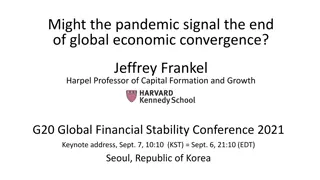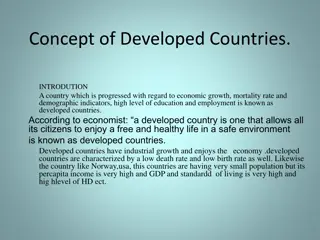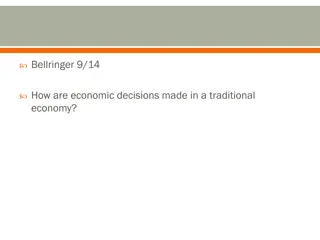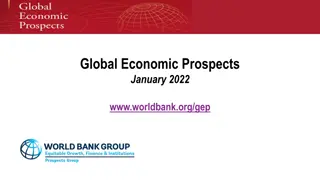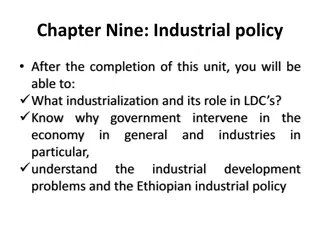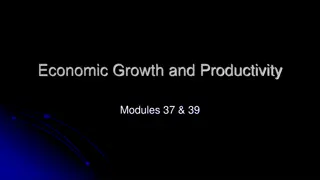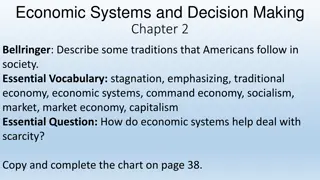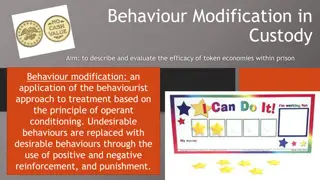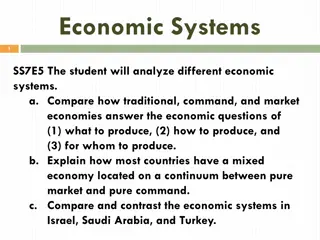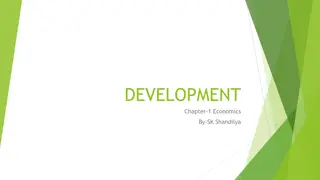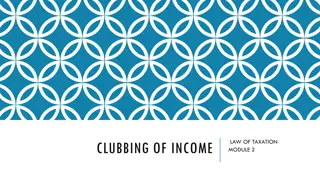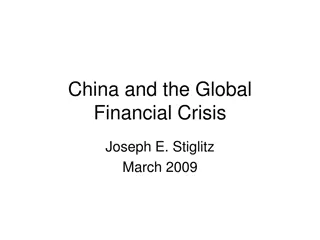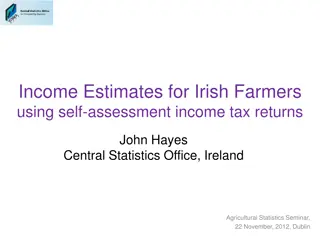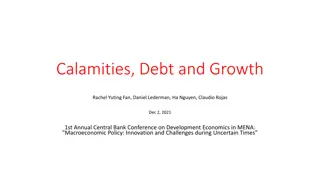Global Economic Update: High-income Economies Accelerating, Developing Countries Facing Challenges
The global economic outlook presents a contrast between high-income economies accelerating in growth while developing countries encounter challenges due to headwinds and capacity constraints. Key messages highlight the need for structural reforms to enhance outcomes. Risks include fallout from the situation in Ukraine, financial tightening risks, and possible contagion from middle-income countries. The latest data indicates continued strengthening in high-income countries, with business confidence improving markedly. Developing countries are experiencing a strengthening short-term cycle with easing financial turmoil but modest growth forecasts.
Download Presentation

Please find below an Image/Link to download the presentation.
The content on the website is provided AS IS for your information and personal use only. It may not be sold, licensed, or shared on other websites without obtaining consent from the author. Download presentation by click this link. If you encounter any issues during the download, it is possible that the publisher has removed the file from their server.
E N D
Presentation Transcript
Global Outlook Update Tightening conditions; narrowing options Tehmina Khan World Bank May 6, 2014 http://www.worldbank.org/globaloutlook 1
Key messages 1. 2. Global economy accelerating led by high-income economies Global trade volumes will rebound buoyed by high-income demand, but USD value of trade will be relatively muted Developing country growth to pick up slowly due to headwinds and capacity constraints Developing-countries have not done enough to restore macroeconomic buffers following the crisis Better outcomes requires further structural reform 3. 4. 5. Risks include: Fallout from situation in the Ukraine Financial tightening risks Possible contagion from middle-income countries 2
Latest data suggests continued strengthening in high income countries Q4 Industrial production, % 3m/3m saar Q1 15 Japan 10 United States 5 Euro area 0 -5 -10 -15 Jan '12 Apr '12 Jul '12 Oct '12 Jan '13 Apr '13 Jul '13 Oct '13 Jan '14 Source: World Bank, Datastream.
Business confidence in high-income countries has improved markedly Main messages Manufacturing PMI (+50=expansion) High-income economies are reviving Developing regions may be slowing, partly in response to Ukraine Trade volumes will rebound buoyed by high-income demand, but USD value of trade will be relatively muted Developing-countries have not done enough to restore macroeconomic buffers following the crisis Better outcomes requires further structural reform Risks include: Fallout from situation in the Ukraine Financial tightening risks Possible contagion from middle-income countries 60 United States 58 56 54 52 Japan 50 EMU 48 46 44 42 40 Jan '11 Jul '11 Jan '12 Jul '12 Jan '13 Jul '13 Jan '14 Source: World Bank, Markit, Haver Analytics. 4
Developing countries Short-term cycle is strengthening Financial turmoil has eased, borrowing costs are up, but remain low Forecast is for modest pickup in growth Growth has been disappointing in some regions 5
Growth firming or solid in most developing countries Industrial production, % 3m/3m saar 15 10 China 5 Dev ex India and China 0 India -5 -10 -15 Feb '12 Aug '12 Feb '13 Aug '13 Feb '14 6 Source: World Bank, Datastream.
Business confidence suggests growth will slow in second quarter Balance of respondents (>50 implies expansion, <50 decline) 59 57 Sub-Saharan Africa Europe & Central Asia 55 South Asia 53 51 49 Latin America & Caribbean China 47 45 Jan '12 Jul '12 Jan '13 Jul '13 Jan '14 Source: World Bank, Markit, National authorities. 7
Financial turmoil has abated, impacts have been limited Gross capital flows, billions USD Most developing countries not affected by turmoil 80 Equity Issuance Bond Issuance Syndicated Bank loans 70 Capital flows have recovered 60 Developing country yields have returned to fall levels, and are actually 55 basis points lower than before the crisis 50 40 30 Markets remain volatile, in part because rising rates will change portfolio decisions 20 10 Vulnerabilities have declined but remain 0 Jan '12 Jul '12 Jan '13 Jul '13 Jan '14 8
Current accounts deficits have narrowed in many of the countries hardest hit during the summer turmoil Current account balance (% of GDP) 6 4 Thailand 2 India 0 Indonesia -2 Brazil -4 South Africa -6 Turkey -8 -10 -12 Jan '10 Jul '10 Jan '11 Jul '11 Jan '12 Jul '12 Jan '13 Jul '13 9 Source: World Bank, Haver.
Outlook Projected pick up in growth to be led by high- income countries Developing-country growth in line with underlying potential Regional growth shows strengthening or stability going forward Slower growth in middle-income countries may reflect weaker than thought potential 10
A gradual pick up in growth, led by high-income countries Percent annual GDP growth 10 Developing 8 5.5 6 5.05.4 4.8 World 3.4 4 3.3 2.9 2.4 High Income 2 2.4 2.4 2.0 1.3 0 -2 -4 2000 2002 2004 2006 2008 2010 2012 2014 2016 Source: World Bank. 11
Contribution of high-income countries to global trade growth will more than double Global Trade, % annual change 15 10 5 0 -5 -10 -15 Contribtion from Developing (% points) Contribtion from High-income (% points) Global Trade Volumes -20 -25 2000 2002 2004 2006 2008 2010 2012 2014 2016 12 Source: World Bank.
Baseline: tighter conditions will reduce flows to developing countries by around of 0.6 % of GDP Estimated decline in capital inflows in the baseline, relative to no policy change: Portfolio Investment Mutual Fund Flows Bank lending FDI 0 0.0 -5 -0.1 -10 -0.2 -15 -0.3 -20 -0.4 Percent change -25 -0.5 Percent of GDP change [Right] -30 -0.6 -35 -0.7 -40 -0.8 -45 -0.9 -50 -1.0 Percent Percent Source: World Bank. 13
Falling commodity or stable commodity prices imply value of trade is growing less quickly USD price of internationally traded commodities, index 2010=100 180 Price declines 2011 y/y Metals -34.0 -12.2 160 Food -13.9 -6.3 140 Energy -9.9 +1.3 Energy 120 Food 100 Metals and Minerals 80 60 40 Jan '05 Jan '06 Jan '07 Jan '08 Jan '09 Jan '10 Jan '11 Jan '12 Jan '13 Jan '14 14 Source: World Bank.
USD value of trade growing much less quickly than in 2000s Growth of USD and volume of international trade Average growth rate nominal USD trade 25 2002-08: 15.9% 2013-16: 5.7% 20 15 10 5 0 -5 Value of trade -10 Volume of trade -15 -20 -25 2000 2002 2004 2006 2008 2010 2012 2014 2016 15 Source: World Bank.
Risks Financial conditions will be tighter over the next five years, implying weaker financial flows, higher capital costs and potential banking-sector stress in economies with rapid expansions in credit over past 5 years Developing countries remain vulnerable: little progress has been made to strengthen developing-country buffers depleted in post-crisis period or push forward with structural reform Financial turmoil in a large middle-income country could induce contagion China risks remain high-short-term and foreign denominated debt in Turkey Situation in Ukraine would likely have minor consequences unless global confidence is shaken 16
Ukraine situation WBG Russia 2014 forecast downgraded 0.9 pp. to 1.3 could be -1.8% in low case scenario Ukraine forecast downgraded to -5.0 percent Rest of world impact likely small unless sanctions intensify or conflict escalates Impacts on global food markets likely marginal Potentially serious impacts on Europe and Russia if there is a disruption in oil and or natural gas supply / demand 17
Downside risks threaten capital flows, risk aversion and GDP GDP, percentage point deviation from baseline, overshooting scenario Taper-related extended increase in US yields Moderate increase in risk aversion (market based) Sharp increase in risk aversion (possibly Ukraine related) 60 2.0 1.5 40 1.0 20 0.5 0 0.0 -0.5 -20 -1.0 -40 -1.5 -60 -2.0 Impact on flows (%) Impact on VIX Impact on GDP (%deviation from baseline) Source: World Bank 18
Tensions between financial stability and growth restructuring in China Restructuring is occurring Growth has slowed sharply (est. 6-6.5% in Q1) Unit labor costs are rising Financial-sector regulations are tightening All 3 imply reduced profitability / liquidity Authorities can respond Have responded with fiscal stimulus of c. 2.5% of GDP but mainly through credit vehicles More than 80% of credit issued by state controlled or owned entities 19
Developing country resilience needs to be built up Countries should be engaged in modest fiscal consolidation Monetary policy has tightened but remains loose Relatively elevated current account deficits imply significant financing needs Metal price declines have put additional pressures on exporters 20
Both structural and actual fiscal deficits much higher than in 2007 # of countries Percent of GDP 0.0 16 -0.5 14 -1.0 12 -1.5 -2.0 10 -2.5 8 -3.0 6 -3.5 -4.0 4 -4.5 2 -5.0 0 2005 2006 2007 2008 2009 2010 2011 2012 2013 Structrural deficit Change in debt -GDP ratio (2013-2007), ppts of GDP Actual Partly as a result, developing country debt to GDP ratios have been rising 21
With limited slack in most regions, inflation has been trending up Output Gaps (% of Potential GDP) Inflation, y/y, % 10 Developing countries 6 8 4 6 2 4 0 2 -2 0 -4 High-income countries -2 -6 2000 2002 2004 2006 2008 2010 2012 2014 1999 2001 2003 2005 2007 2009 2011 2013 China East Asia excl. China P.R. Europe & Central Asia Latin America & Caribbean Middle East & N. Africa South Asia Sub-Saharan Africa
Despite recent rate hikes, real interest rates are low in many developing countries Percent, percentage points 6 4 2 0 -2 -4 Change in real policy rate (since April 2013) Real policy rate -6 -8 Thailand Mexico Georgia Hungary Angola Zambia Turkey Mongolia Ukraine Armenia China India Indonesia Brazil Vietnam Romania South Africa Nigeria Ghana Russia 23 Source: World Bank, Datastream, IMF.
Current account balances of both developing oil importers and exporters have deteriorated Current account balance, % of GDP 2.5 2 1.5 1 0.5 0 Developing oil importers -0.5 Developing oil exporters -1 -1.5 2007 2008 2009 2010 2011 2012 2013 24 Source: World Bank.
Concluding remarks Strengthening recovery in high-income world is supporting developing country growth Positive effects partly offset by tighter financial conditions and supply side constraints Trade volume growth will recover, but the USD value of trade will grow much less quickly than during pre-crisis period Economic risks have declined and are more balances, but geopolitical risks are elevated Developing countries need to do more to build up buffers, and need to reinvigorate structural reforms 25
Global Outlook Update Tightening conditions; narrowing options Andrew Burns World Bank April, 23 2014 http://www.worldbank.org/globaloutlook 26
Extra Slides 27
Except China and Russia stock markets have recovered Index, January 1 2014=100 China Russian Federation South Africa Indonesia Thailand 100 India Turkey 125 Global sell off 120 115 110 105 100 95 90 85 80 01-Jan-14 01-Feb-14 01-Mar-14 01-Apr-14 Source: World Bank, Datastream. 28
Earlier rapid increase in credit increases the risk of banking-sector crises Level of banking-sector net credits in 2012, % of GDP Change in net bank credits, 2012-2007 (% of GDP) 40 180 160 Change in Credit level 35 Credit levels in 2012 140 30 120 25 100 20 80 15 60 10 40 5 20 - - Romania Malawi Lesotho Serbia China Morocco St. Lucia Paraguay Gambia Brazil Bhutan Kosovo Thailand Armenia Venezuela Vanuatu Turkey Botswana Vietnam Malaysia Cambodia Lao PDR Source: World Bank, IMF. 29
Inflation is above target in several economies Inflation, policy rate, % 18 Latest Inflation rate Upper bound of inflation target 16 14 12 10 8 6 4 2 0 Turkey Serbia Romania Mongolia Pakistan Georgia Armenia Mexico Chile Albaia Belarus Ghana Moldova China Hungary Nigeria Botswana Sri Lanka Indonesia Russia Colombia USA India* Kenya Philippines UK Uganda Thailand Peru Japan Brazil Euro area Vietnam Mozambique South Africa Azerbaijan Zambia Dom. Republic 30 Source: World Bank, Datastream, National sources.
Combined Russia and Ukraine are large grain exporters Wheat Russia and Ukraine account for 11 and 5% of global exports But only 0.7 and 0.2% of global production Markets are well supplied Maize Ukraine accounts for 14% of global exports, but only 1 percent of global production Markets are well supplied 31
Russia is #1 world producer of crude oil and a key source of natural gas for the European Union Crude oil World s largest oil producer (> 10mb/d 13% of world production) Exports 7.1 mb/d (4.3 crude, 2.8 refined product) c. 5 mb/d to OECD countries (c. 4 mb/d to Europe) Natural Gas 30% of European natural gas sourced from Russia Half of this transits Ukraine, although about 2/3 of this could be re-routed if disrupted by Ukraine. Germany, Italy, Poland, Hungary and Southern Europe are highly dependent on Russian natural gas Dependencies A 2.7mb/d disruption to Russian exports could push non-Russian prices up 30% 2.7 mb/d represents about 2.5% of Russian GDP and 7% of government revenue A 30% price hike would cost Euro Union about 0.9% of GDP GDP disruptions would likely be higher because of binding supply constraints in natural gas dependent sectors 32
Output to accelerate, but outturns have disappointed GDP, % annual growth 8 2012 2013e 2014f 2015f 2016f 7 6 5 4 3 2 1 0 -1 Europe and Central Asia East Asia and Pacific Latin America and Caribbean Middle East and North Africa South Asia Sub-Saharan Africa Source: World Bank. 33
Even a muted acceleration increases significantly the role of US Change in GDP, trillions of current USD 8 2013-2010 2016-2014 7 6 5 4 3 2 1 0 High-income Developing 34




